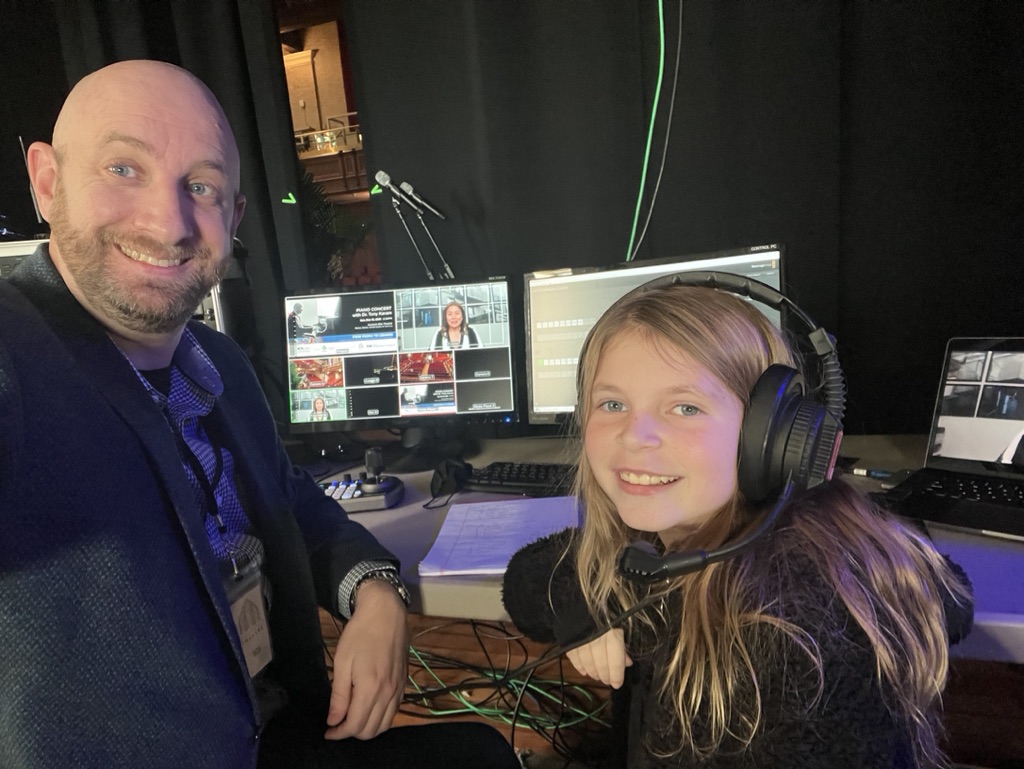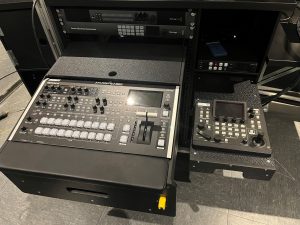- Livestreaming is essential in corporate, live events, esports, and beyond.
- Working with a smaller budget doesn’t mean clients have to suffer.
- Security is of paramount importance in government applications.
- Esports represents one of the most prevalent livestreaming applications.
Livestreaming has always played a relatively large role in the pro AV world. However, it has become a much more critical segment in recent years. The technology used in livestreaming has become a powerful and essential tool in applications ranging from corporate to live events to esports and beyond. Today, we’ll explore the various applications for livestreaming in the pro AV space while shedding light on how this technology can revolutionize how we engage with others and transmit real-time information.
An Explosion in Popularity
“In light of the pandemic, the livestreaming business has exploded in popularity,” says Jeremy Caldera, CTS-D, CTS-I, executive vice president at Pearl Technology. “While there has been growth across the board, the fastest growing vertical we’ve seen are live event productions—whether it’s a corporate event or even a bar with live music, government applications, and houses of worship.”
An Explosion in Popularity
Amanda Eberle, general manager at AV Chicago, has also witnessed pandemic growth in the industry’s live event production and houses of worship segments. “Both of these markets have always been avid proponents of livestreaming technologies. But as the pandemic raged on, we saw growth levels nobody could have predicted.”
She adds: “In addition to the financial growth we’ve seen from additional installations, it’s been fun to experience technological growth. Companies are more willing than ever to test the latest livestreaming technology and experiment with new and different setups.”

Companies are more willing than ever to test the latest livestreaming technology and experiment with new and different setups.
Amanda Eberle
Livestreaming in House of Worship Applications
As Eberle points out, houses of worship have always used livestreaming technology—from megachurches broadcasting their messages to TV channels worldwide to smaller institutions using a simple camera and mic setup to go live on platforms like Facebook.
When the pandemic began in 2020, many churches found themselves in a bind. They were unable to meet in person and wanted to do more than have a pastor use his iPhone to shakily broadcast a Sunday sermon via Facebook Live. These houses of worship were looking for setups that allowed them to spread their messages in a professional manner.
Justin Strazdas, CTS, product marketing manager of video and production at Roland, believes the growth in this market is derived from a combination of technology, education, and passion. “There are fantastic tools out there to create and manage engaging productions, so there are more opportunities to be creative with cameras, media assets, and in-house displays,” he explains. “Ultimately, it takes people inspired by the media they watch to learn and use the tools to continually raise the bar. There’s a strong interest in advanced workflows, and we’re seeing some impressive results.”
According to the experts, budget can be a limiting factor for many houses of worship. “With the exception of megachurches, it’s typical for religious institutions to have limited funds—and their technology budget is no different,” Eberle says. As with any limited client budget, integration firms must work closely with houses of worship to discover their actual technological wants and needs.

Communication is Key
But working with a smaller budget doesn’t mean the client has to suffer, according to Caldera. “I find that communication is key in these situations. You have to dig deep to discover the house of worship’s desired outcome. They may have flashy technology in mind. But at the end of the day, they don’t always need the newest—and often priciest—innovations to reach their livestreaming goals. Often, I find they have a singular goal. Houses of worship want to create an experience online that emulates what is happening in person.”
Products that use an all-in-one approach, like the Roland VR-6HD and VR-120HD Direct Streaming AV Mixers, are ideal for houses of worship. With the VR-6HD, one operator can easily handle all production tasks with minimal study due to the products’ smart interface, deep automation tools, one-touch macro sequencing, and PTZ camera control. The VR-120HD allows a single operator to confidently manage hybrid live and online productions without the need for external gear and the staff to run it—all while offering extensive audio and video I/O, a large touchscreen, and hands-on controls.
So, what does the future hold when it comes to houses of worship and livestreams? “I think you will see more houses of worship use control systems to manage their workflow,” Strazdas predicts. “Open-source community-supported solutions like Bitfocus Companion are increasingly popular because you can control multiple pieces of AV gear with a single button press using an Eglato Streamdeck. Many of Roland’s video switchers have modules available for it, which is great, as it adds even more value to our solutions for houses of worship.”
Houses of worship want to create an experience online that emulates what is happening in person.
Jeremy Caldera
Livestreaming in Government Applications
Years ago, to be involved in politics, one had to attend town halls or address their government representatives via letter (or an email in the early days of the Internet). Today, the times have changed, and it’s easier than ever for citizens to be involved in their government thanks to livestreaming technologies.
“Livestreaming technologies allow every level of government—from a local library board to the state senate—to broadcast their meetings to constituents,” says Pearl Technology’s Caldera. “Unlike other applications where the goal is to replicate the in-person experience, government livestreams often are just start-and-stop applications with limited production value.”
Critical Scenarios
However, Caldera says, that does not mean these applications are any less technologically savvy. In fact, the opposite can be true. Integrators need to consider a myriad of issues when completing a livestreaming installation for the government, starting—first and foremost—with security. While hacking is bad news for any livestreaming application, it is particularly bad for government livestreams, especially ones that aren’t going out to the public and contain sensitive information.
Roland’s Strazdas agrees with the security concerns and believes reliability is an important consideration. “Operators need equipment that is easy to learn and hard to break, especially when the stream is communicating critically important information,” he says. “Software solutions are great for a variety of applications, but I think most systems benefit from a mix of hardware and software to achieve results. I also think controlling as many devices as possible from a single system is helpful—if not essential.”
As in-person fundraising resumed, non-profit and charitable organizations kept the virtual element because they could reach a larger audience using livestreaming technologies.
Amanda Eberle
Accessibility and Engagement
In addition to security and reliability considerations, Caldera recommends providing closed or open captioning services for accessibility, meeting archiving for future reference, and using lower-third text or graphics for clarity and engagement. “Going beyond a simple start/stop with informational data, live camera switching, and adding any type of production value in a user-friendly way adds to the quality of the result,” he says. “The Roland VR Series of Streaming Switchers is great for high production value with ease of use.”
As for the future of livestreaming in government applications, Strazdas believes that having secure, remote-control capabilities is critical as so many pro AV devices are networkable. “Also,” he says, “having broadcast-style livestreaming and videoconferencing as part of the AV system is necessary for many applications. Two of the Roland VR series AV mixers released this year include both USB and direct RTMP streaming, allowing you to have both at the same time.”
Livestreaming in Event Applications
Live events and rental and staging applications have always been ahead of the curve when it comes to livestreaming. COVID-19 only increased the industry’s hunger for virtual—and later hybrid—events.
“The pandemic essentially made livestreaming a requirement for many productions,” Strazdas says. “Today, organizers realize it’s easier than ever to reach as many people as possible with a conference or event. For anyone unable to travel, they can have a remote experience that benefits from increasing production value.”
One particular event segment that has gained popularity in the last few years is non-profit fundraisers. AV Chicago’s Eberle states, “Non-profit and charitable organizations struggled during the height of the pandemic and needed to pivot quickly to discover ways to keep their operations going. They swiftly adapted to using livestreaming technology to host fundraisers and gain additional donations. As in-person fundraising resumed, they kept the virtual element because they could reach a larger audience using livestreaming technologies.”
Increasing Complexity
“I work with several organizations—many of them educational institutions—that have employed livestreaming technologies for fundraising events,” adds Pearl Technology’s Caldera. “While meeting with these clients, one of our key discussion points is always how to ensure the at-home audience is not just watching a video of a stage; we need to ensure the virtual audience is just as engaged as the in-person attendees.”
As part of these engagement strategies, Strazdas believes gamification will be one of the next event livestreaming trends. “When we think about what keeps people engaged with a speaker or a topic, the increasing complexity of audience interaction is fascinating,” he says. “For example, I think leaderboard quizzes are helpful with reinforcing key concepts during a presentation. Plus, they’re usually fun, so I think gamification has a lot of potential to create memorable livestreams.”
Security for Government Applications
Pearl Technology says clients should consider the following points for livestreaming security in government applications:
- Secure Streaming Platform: Choose a reputable streaming platform with solid security measures. Make sure the platform offers end-to-end encryption for data protection and secure login credentials for all participants.
- Protect Personal Data: If a livestreaming event requires registration or collects personal data from participants, it is essential to have proper data protection protocols in place. Use secure databases and limit access to personal information to those who need it.
- Use Secure Internet Connections: Livestreaming events require a stable internet connection, but it is important to use a secure network to prevent unauthorized access to the event. Avoid using public Wi-Fi networks and instead use a dedicated high-security network.
- Utilize Multi-Factor Authentication: Multi-factor authentication adds an extra layer of security to login credentials and helps prevent unauthorized access to the event, especially for admin accounts.
- Monitor for Unusual Activity: Watch for any unusual activity during the livestreaming event, such as unexpected participants or suspicious behavior. This can be an indication of a cyber-attack or data breach.
- Use Waiting Rooms Whenever Possible: You can improve the online security of special events by implementing a waiting room where online attendees must wait before joining the webinar or online event.
- Turn Off Screen Sharing For Attendees: Screen sharing at online events can pose several security risks. For one thing, it puts the participant sharing the screen at risk of jeopardizing their information.
When we think about what keeps people engaged with a speaker or a topic, the increasing complexity of audience interaction is fascinating.
Justin Strazdas
In these types of situations, especially when gamification is involved, it’s critical to use the proper livestreaming technologies, Eberle says, “You can’t just think about the in-the-room audience and what they are seeing—you must consider the content you want the virtual audience to see.”
Solutions like the Roland VR-400UHD 4K AV Streaming Mixer are ideal for such applications. The VR-400UHD is an intuitive solution for managing complex production tasks during in-person and livestreaming events. Side-by-side touchscreens provide fast, direct workflow control and allow users to monitor live video thumbnails, switch composite video scenes, access audio mixing and video routing functions, and more.
Livestreaming in Esports Applications
Esports continues to be one of the most prevalent livestreaming applications, with its popularity ever-growing in the pro AV market.
“There are multiple examples of livestreaming in gaming and esports,” says Eric C. Wallace, president of gaming and esports at Glo Navy, an esports organization founded by hip-hop artist Chief Keef. “On the competitive side, the leagues obviously stream their tournaments for the world to watch—there are even teams and creators streaming these events and reacting to them as watch parties. Some content creators stream anything from gaming to just chatting on any of the popular streaming platforms; just chatting is the most popular category on Twitch.”
“Viewers want to see more than just gameplay,” adds Roland’s Strazdas. “They want to see the players on camera react to the game and, if they are streamers, interact with them. For competition broadcasts, they want the production value of a playoff game for a major sport, requiring a range of AV solutions to put it together.”

In reality, all esports experts we interviewed insisted it’s all about the equipment when livestreaming esports. “You have to understand the consumer, and also cater to and understand the community first and build a rapport with them before you can deem and detail your products,” advises David Chen, North American Collegiate League board member. He believes by getting to know your customer base, you’ll receive better input that can help you grow your technology sales and business.
And what types of technology does that include? “Headset, microphone, interfaces, etc. all help,” says Jairo Urcuyo, CEO and founder of Las Vegas Inferno. “It’s a must-need in streaming. And sometimes, if you do not have the best quality equipment, your content suffers.”
Glo Navy gamer Stephskiii believes the current most popular livestreaming technologies are the microphone and camera from Razer, cameras from Sony, and mini keyboards from various brands.

You have to understand the consumer, and also cater to and understand the community first and build a rapport with them before you can deem and detail your products.
David Chen
Glo Navy Black added that pro AV technologies currently popular with gamers are high-quality cameras and a solid microphone like the Shure SM7B. Those things, paired with a “nice mix amp such as the Roland BRIDGE CAST” and monitors that will be able to hold your frames, and a PC with a GPU able to hold and run everything smoothly, will create a solid livestreaming setup for esports enthusiasts. Stephskii added, “I am currently using the Roland BRIDGE CAST, and it has been a great way to manage my audio on my dual PC setup.”
Urcuyo is also a fan of the BRIDGE CAST. “I love the Roland BRIDGE CAST,” he exclaimed. “It has been the best and simplest way to create content. We [Vegas Inferno] actually used two BRIDGE CAST units to set up a double caster setup for our Mortal Kombat event. If we didn’t have them, we wouldn’t have been able to cast our event.”
Last but not least, Chen also believes in the power of the BRIDGE CAST. “I recommend that [the BRIDGE CAST] to all our people for its functionality, portability, and that it’s small and compact,” he says. Chen enjoys that teams can take the product anywhere—especially when livestreaming—and that it has Bluetooth functionality. “It is exactly what we’re looking for at events like TwitchCon.”

The Importance of Audio
And don’t forget about the importance of audio. “When it comes to audio settings, start with the defaults, record your voice, and listen to how it sounds,” Strazdas advises. “Then watch some tutorials, try some suggestions, and see if that improves it. People obviously have many different voices, so there isn’t a ‘best’ setting that works for everyone. Learning and hearing how effects like a compressor work takes time so less is more when it comes to processing.”
Besides having the latest technology, what other ways can gamers ensure esports success? Urcuyo believes it’s by creating a community. He claims that, too often, gamers put pressure on themselves to hit specific subscriber and engagement numbers, which can take a mental toll on creators. “The best way to measure is [to ask yourself] ‘Are you building a community, and are you and your community having fun doing it?’ The other numbers are definitely important, but not something that should be obsessed with.”
Watch some tutorials, try some suggestions, and see if that improves it. People obviously have many different voices, so there isn’t a ‘best’ setting that works for everyone.
Justin Strazdas
To achieve livestreaming success in the esports segment, Strazdas suggests professionals spend time learning more about their technology by watching tutorials for crucial hardware components. “I like to keep manuals, tutorials, and forum posts bookmarked in a folder for my gear, and it has saved me valuable time when I needed it,” he says.
Livestreaming Evolution and Growth
The world of livestreaming will only continue to grow within the pro AV industry. Whether for houses of worship, government, live events, esports, or something else, these technologies are still growing across all market segments within pro AV and beyond.
“We have always had a streaming option. But, often, it was an afterthought—a static camera in the back of the room that was more than likely more of a recording but could also be pushed to a website. There wasn’t much consideration on the experience of the remote viewer,” Boyer says conclusively. “As the technology has evolved, there is more thought put into the why of the livesteam, and the future is exciting for the continued adoption of livestreaming.”




